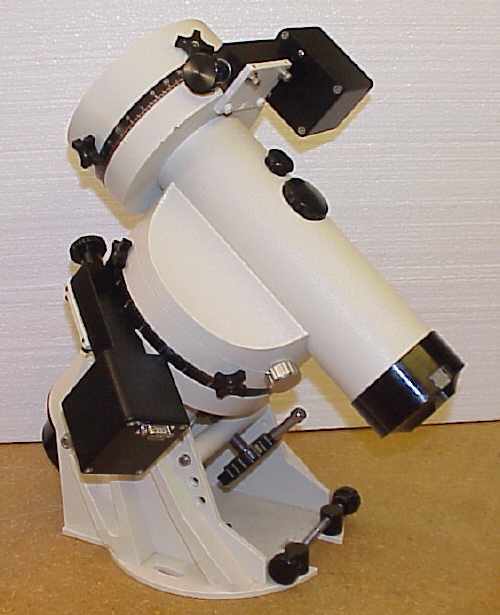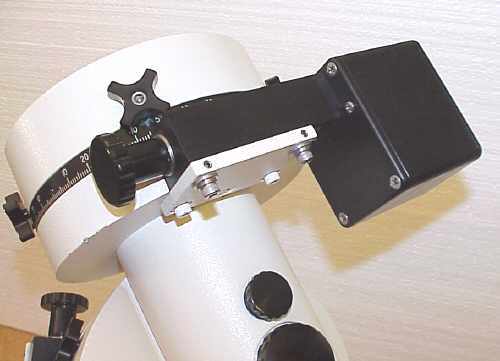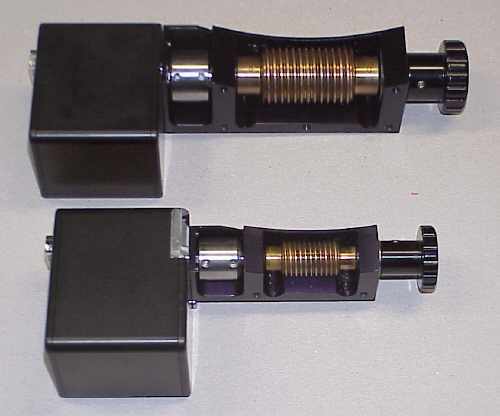Sie
können die FS2 an den ASTRO PHYSICS 900 und 1200 Montierungen verwenden.
Wenn
die Original-Schrittmotore verwendet werden, dann ist die maximale Schwenkgeschwindigkeit
relativ klein. Das liegt an der sehr großen Getriebe-Untersetzung.
Bei 12 Volt ist die Geschwindigkeit etwa 32-fach, bei 30 Volt etwa 50x
und bei 40 Volt etwa 64x.
Die
in den Motor-Gehäusen vorhandene Elektronik wird entfernt und der
Motor wird direkt an die runde Steckverbindung angelötet.
Sie
brauchen ausser der FS2 nur noch passende Anschlusskabel, die von ASTRO
ELECTRONIC erhältlich sind.
Es
besteht aber auch die Möglichkeit, die Montierung auf ESCAP Motore
umzubauen und dabei die Getriebe-Untersetzung zu verkleinern, so dass wesentlich
schnelleres Schwenken möglich wird.
Wir
vewenden hierbei den ESCAP P530 Motor. Bei der AP900 Montierung wird ein
12:1 Vorgetriebe verwendet, während bei der AP1200 Montierung wahlweise
ein 12:1 oder ein 24:1 Getriebe verwendet werden kann. Selbstverständlich
ist sichergestellt dass keine Vibrationen vom Motor auf das Fernrohr übertragen
werden.
Das
12:1 Getriebe ist besser geeignet wenn schnelles Schwenken wichtig ist.
Das
24:1 Getriebe ist besser geeignet wenn das Teleskop ein hohes Gewicht hat.
Dieser
Umbau ist nicht ganz einfach und erfordert einige Änderungen an den
CNC-Gehäusen und an den Lagerblöcken der Schnecken:
--
An beiden Lagerblöcken der Schnecken werden die Gewindebohrungen (wo
das Gehäuse befestigt wird) auf M3 geändert.
--
In beide CNC-Gehäuse werden die passenden Befestigungs-Löcher
gebohrt.
--
Beim Gehäuse des Rekt.-Motors muss eine Ecke abgefräst werden,
da wo das Gehäuse den Teilkreis berührt.
--
Beim Gehäuse des Dekl.-Motors muss auch eine Ecke abgefräst werden,
weil sonst die vier Dekl.-Klemmschrauben das Gehäuse berühren
würden. Alternativ könnten auch kleinere Klemmschrauben verwendet
werden.
--
Bei der Wellenkupplung des Rekt.-Motors muss der Durchmesser von 3/16"
auf 5.00mm aufgerieben werden, wobei selbstverständlich kein Fluchtungsfehler
entstehen darf. Das betrifft nicht alle Montierungen, bei manchen ist die
Motorwelle schon 5.00mm.
Wir
können diese Arbeiten übernehmen. Schicken Sie uns nur die Schnecken
incl. der Lagerungen. Die alten Motore können Sie vorher entfernen
oder mitschicken, ganz wie Sie möchten.
Sehr
gute Verpackung bitte, die Schnecken sind Präzisionsteile und von
der Genauigkeit hängt der periodische Fehler der Montierung ab!
Sehr
wichtig: Bevor Sie die Teile abbauen, drehen Sie bitte die Schnecken in
solch eine Position dass die Klemmschrauben in der Wellenkupplung zugänglich
sind! Wir haben die Original-Elektronik nicht und können den Original-Motor
nicht drehen lassen! |
You
can use the FS2 with the ASTRO PHYSICS 900 and 1200 mounts.
If
the original motors are used, the maximum slewing speed is quite low because
of the very big gear ratio.
The
maximum slewing speed is about 32x at 12 Volts or 50x at 30 or 40 Volts.
The
electronics which is in the original motor's housings is removed and the
motor's wires are directly soldered to the connectors.
Besides
the FS2 drive unit you need only two new cables for the motors.
It
is also possible to replace theoriginal motors by swiss made ESCAP motors.
The gear ratio is decreased so that faster slewing becomes possible. We
use the ESCAP P530 motors. In the AP900 a 12:1 gearbox is used, and in
the AP1200 you can choose between 12:1 and 24:1.
Of
course the gear ratio is big enough so that absolutely no vibrations from
the motor are visible in the eyepiece.
Choose
the 12:1 gearbox if fast slewing is important.
Choose
the 24:1 gearbox if there is a heavy telescope on the mount.
Unfortunately
these modifications are not easy:
--
At both housings of the worms the holes (where the motor is attached) are
changed to bigger M3 size.
--
The four holes must be drilled into the housings.
--
One corner of the RA motor housing must be milled off, where the housing
touches the setting circle.
--
At the housing of the declination motor there must also a corner be milled
off. Otherwise the four big screws of the dec axis clutch would touch the
housing.
--
The diameter of the RA shaft coupling must be changed from 3/16" to 5.00mm,
because the new gearbox has a 5mm shaft.
This
must be made with a reamer in a lathe and extremely care must be taken
that the hole is aligned correctly. This s not necessary at all mounts,
some do already have a motor with 5.00mm shaft.
We
can make these works. You send us only the worm assemblies from your mount.
If you want, you can also remove the old motors and motor housings before
shipping.
Very
good packing please, the worms are precision parts and the size of the
periodic error depends on them.
Very
important: Before disassembling, please turn the worm in such a position
that the setting screws of the shaft coupling are accessible! We don't
have the original electronics and can't turn the original motor!
|








